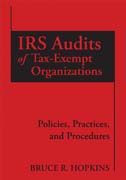
IRS audits of tax-exempt organizations: policies, practices, and procedures
Hopkins, Bruce R.
This practical book offers a complete analysis of the procedures and practices of the IRS in its audits of tax-exempt organizations. Written by Bruce R. Hopkins, the foremost expert on nonprofit law, it provides detailed documentation and citations. INDICE: Preface. 1. IRS Audits of Tax-Exempt Organizations Fundamentals. 1.1 Introduction to IRS Exempt Organizations Audit Procedures. 1.2 Reasons for IRS Audits. 1.3 IRS Audit Issues Introduction. 1.4 IRS Audit Procedures in General. 1.5 Tax-Exempt Organizations' Rights. 1.6 Types of IRS Examinations. (a)Field Examinations. (b) Office and Correspondence Examinations. (c) Team Examinations. (d) Compliance Check Projects. 1.7 IRS Audit Controversy. 1.8 IRS Summons Authority. 1.9 Technical Advice. (a) General Procedures in Exempt Organizations Context. (b) Pre-Submission Conferences. (c) Contents of TAM Requests.(d) Handling of TAM Requests. (e) Appeals of Decisions to Not Seek Advice. (f) Withdrawal of TAM Requests. (g) Conference Scheduling. (h) IRS Use of TAMs. (i) Effect of TAM. (j) Limited Retroactive Effect of TAM. (k) Future Use of TAMs. 1.10 Closing Agreements. (a) Overall Purpose of Closing Agreements. (b) Authority and Function. (c) Scope. (d) Finality. (e) Closing Agreements in Exempt Organizations Context. 1.11 Freedom of Information Act. 1.12 Expansion of IRS Exempt Organizations Audit Activity. 1.13 Current and Future Focus of IRS Exempt Organizations Audits. 2. Organization of IRS. 2.1 Structure of Departmentof Treasury. (a) Treasury Department in General. (b) Treasury Inspector General for Tax Administration. 2.2 IRS in General. 2.3 Tax Exempt and Government Entities Division. (a) Overall Organization. (b) Customer Profile. (c) Operations. (d) Enforcement Function. 2.4 Headquarters Mission. (a) Senior Technical Advisor. (b) Planning. (c) Finance. (d) Communications and Liaison. (e) Business Systems Planning. (f) Research and Analysis. 2.5 Examinations Office. 2.6 Customer Education and Outreach. 2.7 Rulings and Agreements. 2.8 Program Management. 2.9 Customer Accounts Services. 2.10 IRS Administrative Functions. 2.11 Appeals. (a) Organization, Priorities, and Mission. (b) Appeals Function and Tax-Exempt Organizations. 2.12 Office of National Taxpayer Advocate. (a) MissionFulfillment. (b) Organization. (c) General Rules. (d) Systemic Advocacy. (e) TAS and Tax-Exempt Organizations. 2.13 Practice Before IRS. 3. Managing Tax-Exempt Organizations IRS Audits. 3.1 Pre-Audit Precautions. (a) Review GoverningInstruments. (b) Review Operations. (c) Review Books and Records. (d) Review Publications. (e) Review Correspondence. (f) Review Minutes. (g) Review Federal Returns. (h) Review Contracts. (i) Conflict-of-Interest Policy. (j) Other Documents. (k) Review Web Site. (l) Employment Taxes. (m) Media Coverage. (n) Testaments. (o) Governance. (p) Legal Audit. 3.2 Winning Audit Lottery: Initial Steps and Reactions. (a) Telephone Call. (b) Notice of Examination. (c) Documents Requested. (d) Get Organized. (e) Contact Person. (f) Communications Strategy. (g) Know the Cast. (h) Office Facilities for IRS. (i) Initial and Other Interviews. (j) First Impressions..etc.
- ISBN: 978-0-470-11516-9
- Editorial: John Wiley & Sons
- Encuadernacion: Cartoné
- Páginas: 432
- Fecha Publicación: 26/03/2008
- Nº Volúmenes: 1
- Idioma: Inglés
